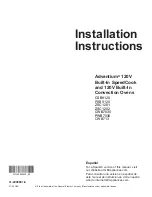
5958 992 00
EN
15
1.3 UNPACKAGING
• Remove the appliance from the packaging and take away the
protective film that covers the appliance's external panels careful-
ly to avoid leaving any trace of glue. If necessary remove the glue
using an a non-corrosive solvent, rinsing it off and drying carefully.
• Dispose of packaging material in compliance with the regulations
in force in the country where the product is to be used.
1.4 IMMEDIATELY INSPECT FOR SHIPPING DAMAGE
The container should be examined for damage before and during
unloading. The freight carrier has assumed responsibility for its
safe transit and delivery. If damaged equipment is received,
either apparent or concealed, a claim must be made with the
delivering carrier. Apparent damage or loss must be noted on the
freight bill at the time of delivery. The freight bill must then be
signed by the carrier representative (Driver). If the bill is not
signed, the carrier may refuse the claim. The supply can supply
the necessary forms. A request for inspection must be made to
the carrier within 15 days if there is concealed damage or loss that
is not apparent until after the equipment is uncrated. The carrier
should arrange an inspection. Be certain to hold all contents plus
all packing material. Under no circumstances should a damaged
appliance be returned to the manufacturer without prior notice and
written authorization.
2. POSITIONING
• For the overall space required and connection dimensions, re-
fer to the installation diagrams given on the first pages of this
instruction handbook.
• The left, right and top surface of the appliance must remain
at least
23.62" (50cm)
from other surfaces to enable maintenance
interventions (if not possible, minimum 1.97" -5cm- is request for
left and right), whereas the back must be at least
1.97" (5cm)
from any surface.
• Position the appliance and if necessary adjust the height of the
worktop by means of the adjustable feet.
• The appliance is not suitable for built-in installation.
Important
:
Make sure the steam coming from the oven discharge or
adjacent appliances does not reach the special vents for
the cooling of internal components, located at the
bottom of the appliance.
3. ELECTRICAL CONNECTION
• A fused disconnect switch or main circuit breaker (customer
furnished) MUST be installed in the electric supply line for the
appliance. It is recommended that this switch/circuit breaker
have lockout/tagout capability. Before making any electrical
connections to this appliance, check that the power supply is
adequate for the voltage, amperage, and phase requirements
on the rating plate.
• A safety cutout switch of suitable capacity with a contact
breaking distance of at least 3 mm must be fitted upstream of the
appliance.
The cutout switch must be installed near the appliance in the
permanent electrical system of the premises.
Important
: The external panels of the oven must be
removed for the operations described in this section. As the
unit must be operating in order to carry out some
adjustments, pay maximum attention to the live parts
.
1. PLACE OF INSTALLATION
1.1 VENTILATION
The necessity for a properly designed and installed ventilation
system cannot be over emphasized. The ventilation system will
allow the unit to function properly while removing unwanted vapors
and products of combustion from the operating area.
The appliance must be vented with a properly designed mechanically
driven exhaust hood. The hood should be sized to completely cover
the equipment plus an overhang of a least 6"/15.3cm on all sides not
adjacent to a wall. The capacity of the should be sized appropriately
and provisions for adequate makeup air.
Refer to your local ventilation codes. In the absence of local codes,
refer to the National ventilation code titled, “Standard for the
Installation of Equipment for the Removal of Smoke and Grease
Laden Vapors from Commercial Cooking Equipment”, NFPA-96-
Latest Edition.
It is recommended that the ventilation system and duct work be
checked at prevailing intervals as specified by the hood manufactured
• The appliance must only be installed in adequately ventilated
premises.
NOTICE:
Proper ventilation is the owner's is responsibility. Any
problem due to improper ventilation will not be covered by the
warranty.
1.2 REFERENCE STANDARDS
Note:
The electric supply installation must satisfy the requirements
of the appropriate statutory authority, such as the National Electrical
Code (NEC) ANSI/NFPA70, (U.S.A..): the Canadian Electrical
Code, CSA C22.2; or other applicable regulations.
Note:
The electric supply connection must meet all national and
local electrical code requirements.
Note:
The installation of this unit must conform to local codes or,
in the absence of local codes, to all National Codes governing
plumbing, sanitation, safety and good trade practices, and to the
National Gas Code ANSI Z223.1.
• Local codes regarding installation vary greatle from one area to
another. This equipment is to be installed to comply with the
applicable federal, state or local codes.
The installation instructions contained herein are for the use of
qualified installation and service personnel only. Installation or
service by other than qualified personnel may result in damage to
the appliance and/or injury to the operator.
FAILURE TO COMPLY WITH INSTALLATION INSTRUCTION
OR IMPROPER INSTALLATION WILL VOID WARRANTY AND
RESPONSIBLITIES OF THE MANUFACTURE.
The National Fire Protection Association, Inc states in its NFPA 96
latest edition that local codes are the "authority having jurisdiction"
when it comes to installation requirements for equipment.
Therefore, installations should comply with all local codes.
II. INSTALLATION INSTRUCTIONS
















































